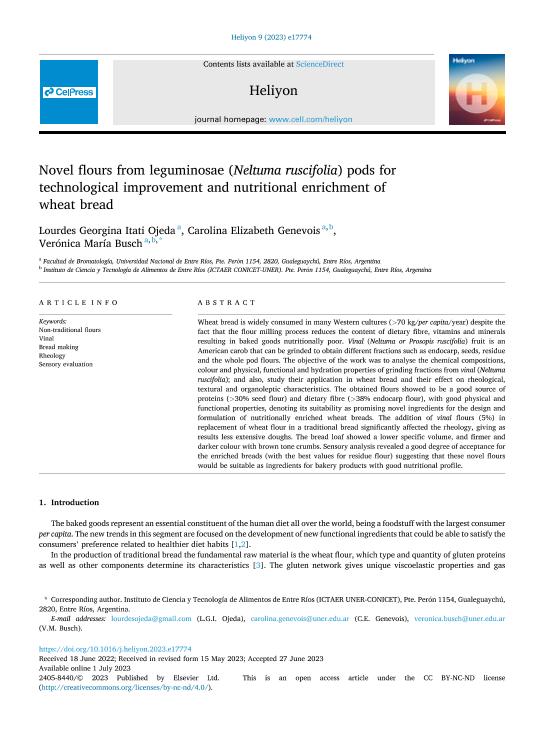Mostrar el registro sencillo del ítem
dc.contributor.author
Ojeda, Lourdes Georgina Itati
dc.contributor.author
Genevois, Carolina Elizabeth

dc.contributor.author
Busch, Verónica María

dc.date.available
2024-02-05T17:53:53Z
dc.date.issued
2023-07
dc.identifier.citation
Ojeda, Lourdes Georgina Itati; Genevois, Carolina Elizabeth; Busch, Verónica María; Novel flours from leguminosae (Neltuma ruscifolia) pods for technological improvement and nutritional enrichment of wheat bread; Cell Press; Heliyon; 9; 7; 7-2023; 1-10
dc.identifier.issn
2405-8440
dc.identifier.uri
http://hdl.handle.net/11336/225870
dc.description.abstract
Wheat bread is widely consumed in many Western cultures (>70 kg/per capita/year) despite the fact that the flour milling process reduces the content of dietary fibre, vitamins and minerals resulting in baked goods nutritionally poor. Vinal (Neltuma or Prosopis ruscifolia) fruit is an American carob that can be grinded to obtain different fractions such as endocarp, seeds, residue and the whole pod flours. The objective of the work was to analyse the chemical compositions, colour and physical, functional and hydration properties of grinding fractions from vinal (Neltuma ruscifolia); and also, study their application in wheat bread and their effect on rheological, textural and organoleptic characteristics. The obtained flours showed to be a good source of proteins (>30% seed flour) and dietary fibre (>38% endocarp flour), with good physical and functional properties, denoting its suitability as promising novel ingredients for the design and formulation of nutritionally enriched wheat breads. The addition of vinal flours (5%) in replacement of wheat flour in a traditional bread significantly affected the rheology, giving as results less extensive doughs. The bread loaf showed a lower specific volume, and firmer and darker colour with brown tone crumbs. Sensory analysis revealed a good degree of acceptance for the enriched breads (with the best values for residue flour) suggesting that these novel flours would be suitable as ingredients for bakery products with good nutritional profile.
dc.format
application/pdf
dc.language.iso
eng
dc.publisher
Cell Press

dc.rights
info:eu-repo/semantics/openAccess
dc.rights.uri
https://creativecommons.org/licenses/by-nc-nd/2.5/ar/
dc.subject
BREAD MAKING
dc.subject
NON-TRADITIONAL FLOURS
dc.subject
RHEOLOGY
dc.subject
SENSORY EVALUATION
dc.subject
VINAL
dc.subject.classification
Alimentos y Bebidas

dc.subject.classification
Otras Ingenierías y Tecnologías

dc.subject.classification
INGENIERÍAS Y TECNOLOGÍAS

dc.title
Novel flours from leguminosae (Neltuma ruscifolia) pods for technological improvement and nutritional enrichment of wheat bread
dc.type
info:eu-repo/semantics/article
dc.type
info:ar-repo/semantics/artículo
dc.type
info:eu-repo/semantics/publishedVersion
dc.date.updated
2024-02-05T13:52:36Z
dc.journal.volume
9
dc.journal.number
7
dc.journal.pagination
1-10
dc.journal.pais
Países Bajos

dc.journal.ciudad
Amsterdam
dc.description.fil
Fil: Ojeda, Lourdes Georgina Itati. Universidad Nacional de Entre Ríos. Facultad de Bromatología; Argentina
dc.description.fil
Fil: Genevois, Carolina Elizabeth. Consejo Nacional de Investigaciones Cientificas y Tecnicas. Centro Cientifico Tecnologico Conicet - Santa Fe. Instituto de Ciencia y Tecnologia de Los Alimentos de Entre Rios. - Universidad Nacional de Entre Rios. Instituto de Ciencia y Tecnologia de Los Alimentos de Entre Rios.; Argentina. Universidad Nacional de Entre Ríos. Facultad de Bromatología; Argentina
dc.description.fil
Fil: Busch, Verónica María. Consejo Nacional de Investigaciones Cientificas y Tecnicas. Centro Cientifico Tecnologico Conicet - Santa Fe. Instituto de Ciencia y Tecnologia de Los Alimentos de Entre Rios. - Universidad Nacional de Entre Rios. Instituto de Ciencia y Tecnologia de Los Alimentos de Entre Rios.; Argentina. Universidad Nacional de Entre Ríos. Facultad de Bromatología; Argentina
dc.journal.title
Heliyon
dc.relation.alternativeid
info:eu-repo/semantics/altIdentifier/url/https://www.sciencedirect.com/science/article/pii/S2405844023049824
dc.relation.alternativeid
info:eu-repo/semantics/altIdentifier/doi/http://dx.doi.org/10.1016/j.heliyon.2023.e17774
Archivos asociados
